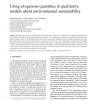Free Online Productivity Tools
i2Speak
i2Symbol
i2OCR
iTex2Img
iWeb2Print
iWeb2Shot
i2Type
iPdf2Split
iPdf2Merge
i2Bopomofo
i2Arabic
i2Style
i2Image
i2PDF
iLatex2Rtf
Sci2ools
AICOM
2007
2007
Using exogenous quantities in qualitative models about environmental sustainability
Representing the impact of external factors on the behaviour of a system is a challenge for modellers, particularly when these factors are dynamic and may change during the simulation. This article presents mechanisms implemented in the qualitative reasoning engine Garp3 for modelling quantities that exhibit exogenously defined behaviours. Exogenous quantities are those that influence the system but are not influenced by quantities represented in the system. Seven types of mechanisms for handling exogenous quantities are implemented: “constant”, “generate all values”, “increasing”, “decreasing”, “steady”, “sinusoidal”, and “random”. Examples drawn from models of environmental sustainability (related to Millennium Development Goal 7) are used to illustrate the functioning of these primitives. Individually or combined, the mechanisms provide many options for modellers to represent cycles, oscillations, and regions of local stability.
| Added | 08 Dec 2010 |
| Updated | 08 Dec 2010 |
| Type | Journal |
| Year | 2007 |
| Where | AICOM |
| Authors | Bert Bredeweg, Paulo Salles, Tim Nuttle |
Comments (0)

